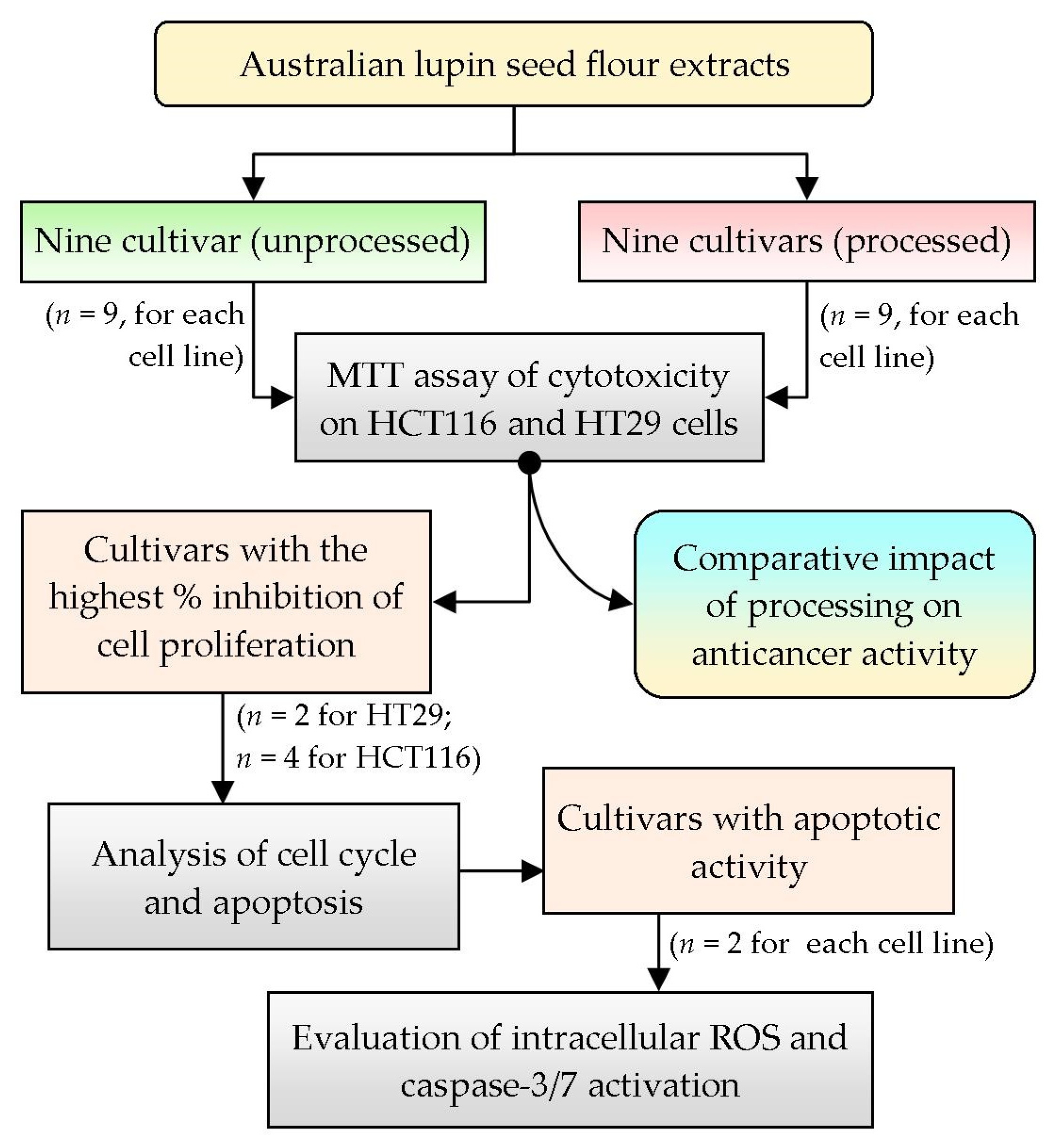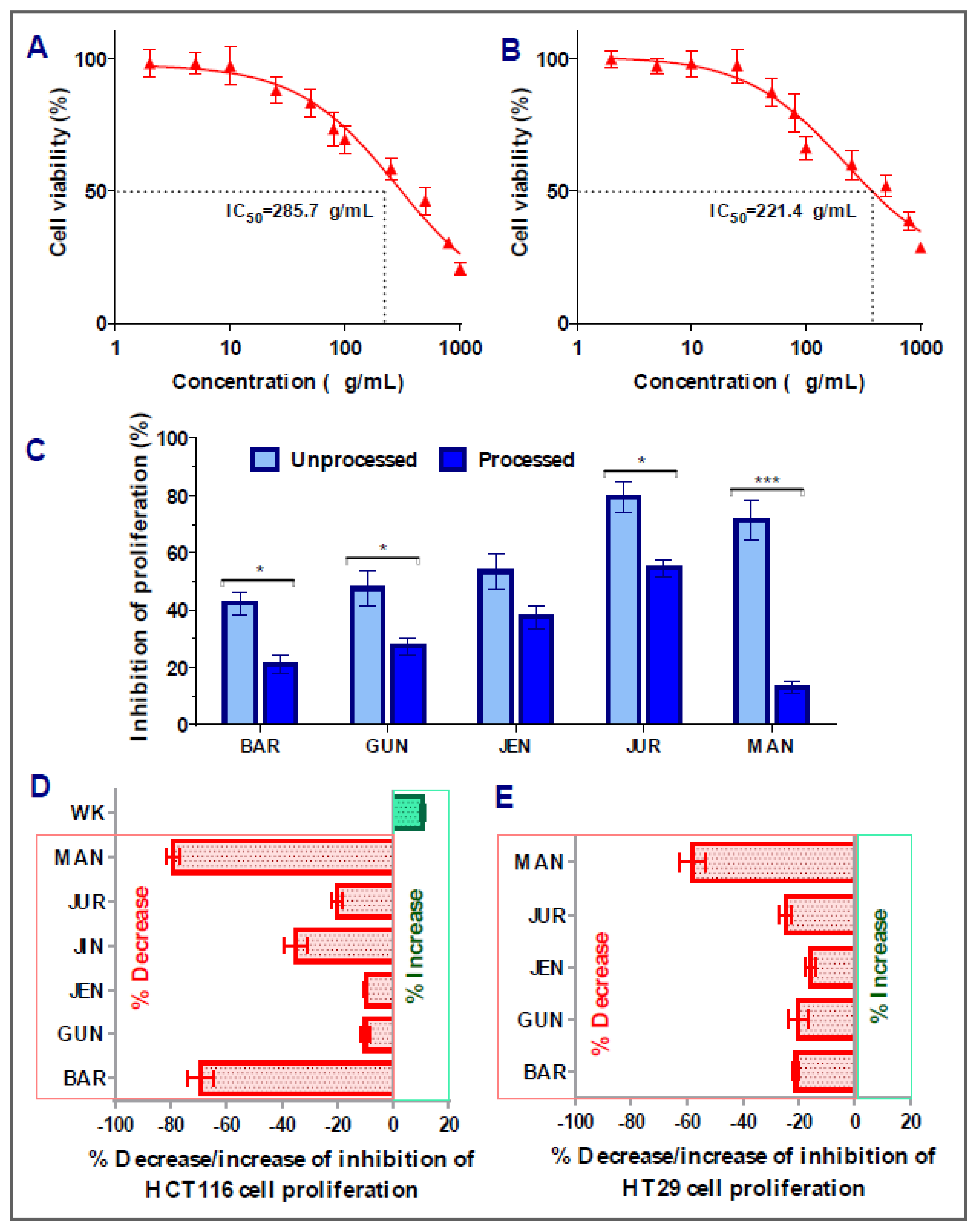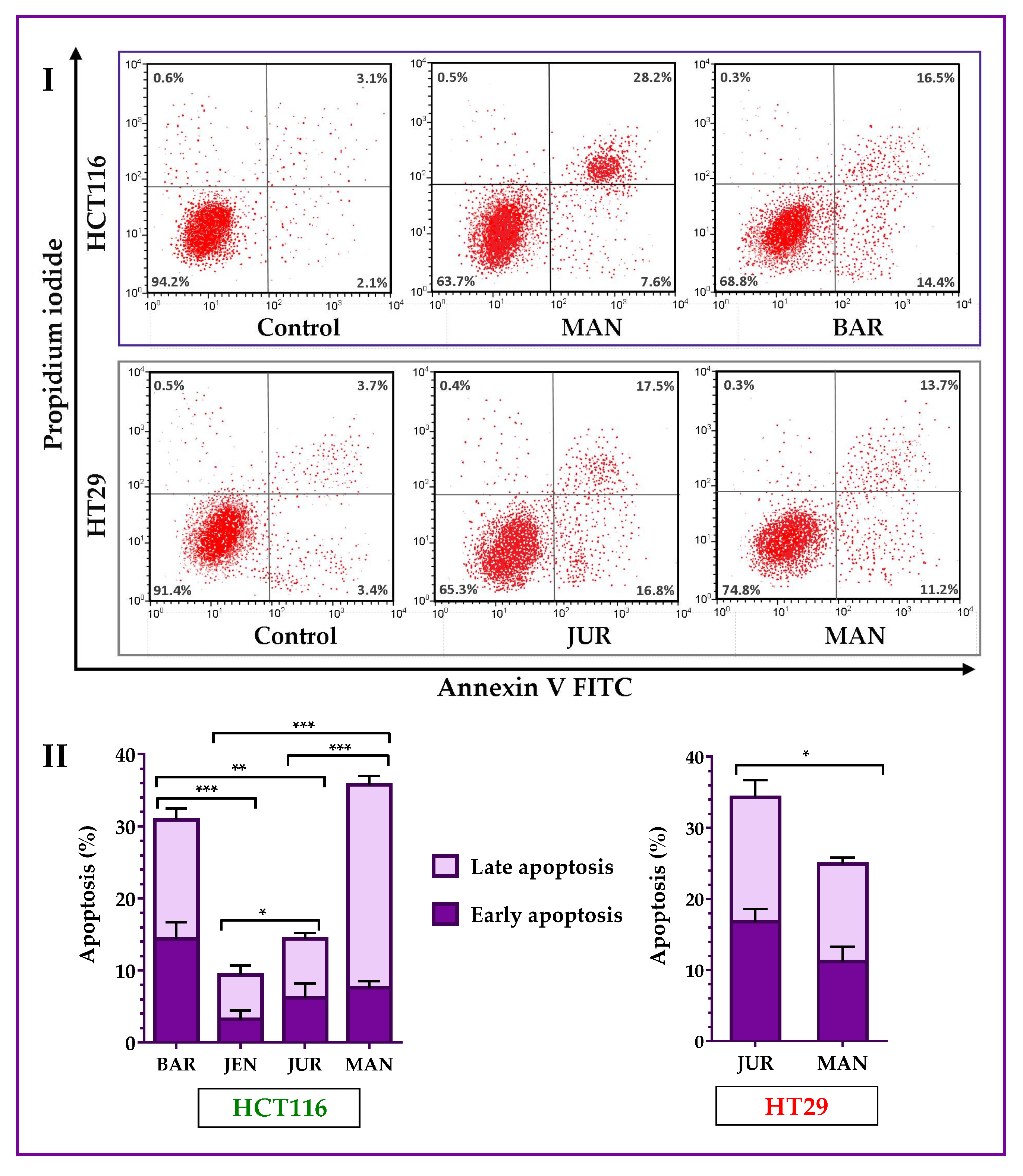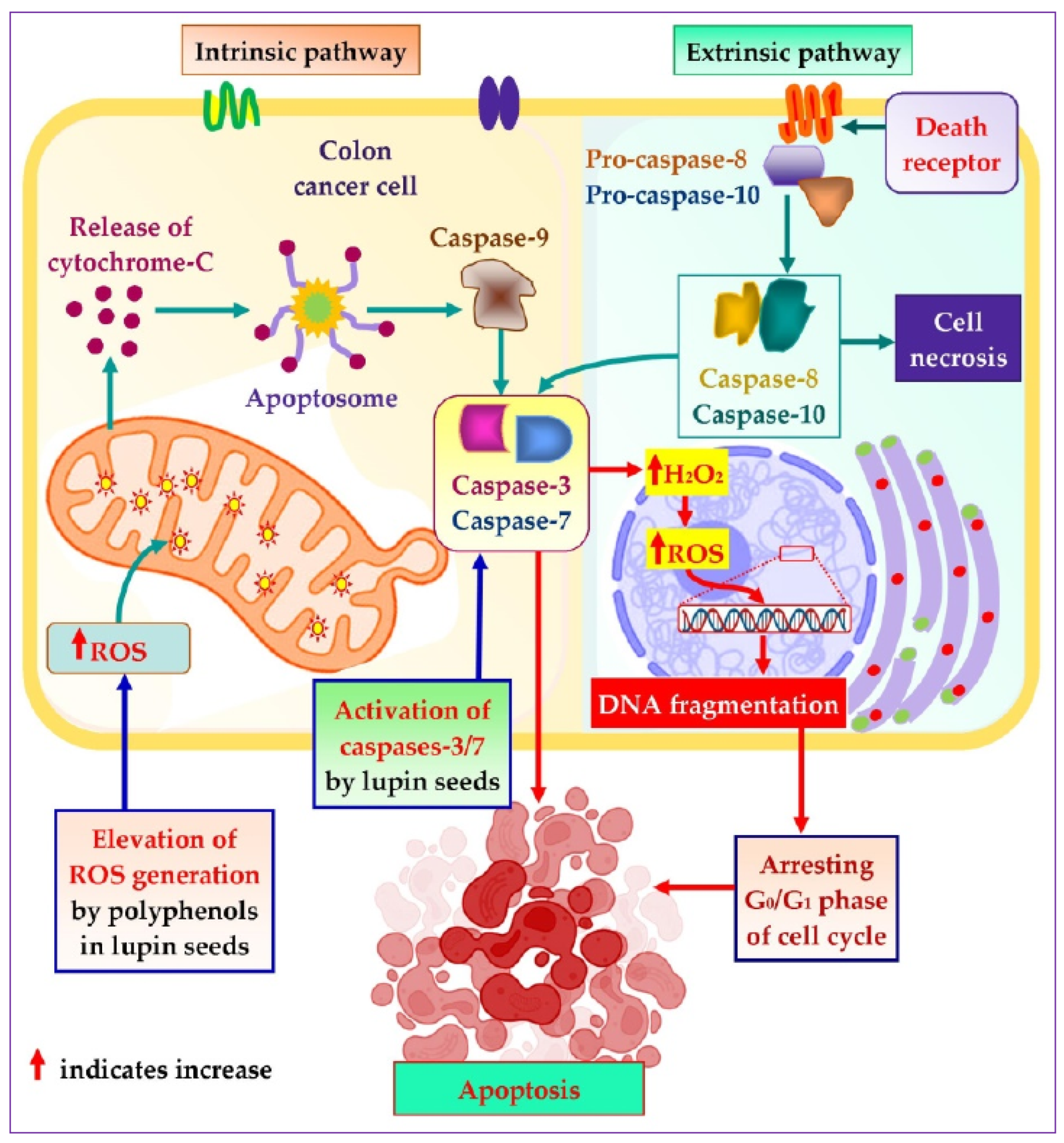Attenuating Colorectal Cancer Using Nine Cultivars of Australian Lupin Seeds: Apoptosis Induction Triggered by Mitochondrial Reactive Oxygen Species Generation and Caspases-3/7 Activation
Abstract
:1. Introduction
2. Materials and Methods
2.1. Chemicals
2.2. Raw Materials
2.3. Processing of Lupin Seeds
2.4. Extraction of Lupin Seed Flour
2.5. Assessment of Attenuating Effects on Colon Cancer
2.5.1. Cell Culture
2.5.2. Cell Viability Assay
2.5.3. Quantification of Apoptosis through Annexin V Assay
2.5.4. Reactive Oxygen Species Detection
2.5.5. Caspase-3/7 Detection Assays
2.6. Statistical Analysis
3. Results
3.1. Concentration-Dependent Cytotoxic Effects of Lupin Seed Flours on Colon Cancer
3.2. Impact of Processing of Lupin Flours on Inhibition of Colon Cancer Cells’ Proliferation
3.3. Induction of Apoptosis and Cell Cycle Arrest by Lupin Seed Flour Extracts
3.4. Generation of Mitochondrial ROS by Lupin Seed Flour Extracts
3.5. Activation of Caspase-3/7 by Lupin Seed Flour Extracts
4. Discussion
5. Conclusions
Supplementary Materials
Author Contributions
Funding
Institutional Review Board Statement
Informed Consent Statement
Data Availability Statement
Conflicts of Interest
References
- Mazumder, K.; Biswas, B.; Kerr, P.G.; Blanchard, C.; Nabila, A.; Golder, M.; Aziz, M.G.; Farahnaky, A. Comparative assessment of nutritional, thermal, rheological and functional properties of nine Australian lupin cultivars. Sci. Rep. 2021, 11, 21515. [Google Scholar] [CrossRef]
- Mazumder, K.; Nabila, A.; Aktar, A.; Farahnaky, A. Bioactive variability and in vitro and in vivo antioxidant activity of unprocessed and processed flour of nine cultivars of Australian lupin species: A comprehensive substantiation. Antioxidants 2020, 9, 282. [Google Scholar] [CrossRef]
- French, R.J.; Buirchell, B.J. Lupin: The largest grain legume crop in Western Australia, its adaptation and improvement through plant breeding. Aust. J. Agric. Res. 2005, 56, 1169–1180. [Google Scholar] [CrossRef]
- Zhong, L.; Fang, Z.; Wahlqvist, M.L.; Wu, G.; Hodgson, J.M.; Johnson, S.K. Seed coats of pulses as a food ingredient: Characterization, processing, and applications. Trends Food Sci. Technol. 2018, 80, 35–42. [Google Scholar] [CrossRef]
- Siger, A.; Czubinski, J.; Kachlicki, P.; Dwiecki, K.; Lampart-Szczapa, E.; Nogala-Kalucka, M. Antioxidant activity and phenolic content in three lupin species. J. Food Compos. Anal. 2012, 25, 190–197. [Google Scholar] [CrossRef]
- Khan, M.K.; Karnpanit, W.; Nasar-Abbas, S.M.; Huma, Z.e.; Jayasena, V. Phytochemical composition and bioactivities of lupin: A review. Int. J. Food Sci. Technol. 2015, 50, 2004–2012. [Google Scholar] [CrossRef]
- Mazumder, K.; Hossain, M.; Aktar, A.; Dash, R.; Farahnaky, A. Biofunctionalities of unprocessed and processed flours of Australian lupin cultivars: Antidiabetic and organ protective potential studies. Food Res. Int. 2021, 147, 110536. [Google Scholar] [CrossRef]
- Mazumder, K.; Chinkwo, K.; Farahnaky, A.; Kerr, P. The potential of lupin as a functional food for the prevention of diabetes and pancreatic cancer. In Proceedings of the 68th Australasian Grain Science Conference, Wagga Wagga, Australia, 10–13 September 2018. [Google Scholar]
- Tran, K.B.; Lang, J.J.; Compton, K.; Xu, R.; Acheson, A.R.; Henrikson, H.J.; Kocarnik, J.M.; Penberthy, L.; Aali, A.; Abbas, Q. The global burden of cancer attributable to risk factors, 2010–19: A systematic analysis for the Global Burden of Disease Study 2019. Lancet 2022, 400, 563–591. [Google Scholar] [CrossRef]
- Shrimahitha, D.; Mayowa, A.; Nisha, M.; Vinutna, G.; Kruthiga, R. Colon Cancer and Obesity: A Narrative Review. Cureus 2022, 14, e27589. [Google Scholar]
- Horvat, N.; Carlos Tavares Rocha, C.; Clemente Oliveira, B.; Petkovska, I.; Gollub, M.J. MRI of rectal cancer: Tumor staging, imaging techniques, and management. Radiographics 2019, 39, 367–387. [Google Scholar] [CrossRef]
- Chapelle, N.; Martel, M.; Toes-Zoutendijk, E.; Barkun, A.N.; Bardou, M. Recent advances in clinical practice: Colorectal cancer chemoprevention in the average-risk population. Gut 2020, 69, 2244–2255. [Google Scholar] [CrossRef]
- Hossain, M.S.; Karuniawati, H.; Jairoun, A.A.; Urbi, Z.; Ooi, D.J.; John, A.; Lim, Y.C.; Kibria, K.K.; Mohiuddin, A.; Ming, L.C. Colorectal cancer: A review of carcinogenesis, global epidemiology, current challenges, risk factors, preventive and treatment strategies. Cancers 2022, 14, 1732. [Google Scholar] [CrossRef]
- Matsuda, T.; Yamashita, K.; Hasegawa, H.; Oshikiri, T.; Hosono, M.; Higashino, N.; Yamamoto, M.; Matsuda, Y.; Kanaji, S.; Nakamura, T. Recent updates in the surgical treatment of colorectal cancer. Ann. Gastroenterol. Surg. 2018, 2, 129–136. [Google Scholar] [CrossRef]
- Xie, Y.-H.; Chen, Y.-X.; Fang, J.-Y. Comprehensive review of targeted therapy for colorectal cancer. Signal Transduct. Target. Ther. 2020, 5, 22. [Google Scholar] [CrossRef]
- Mármol, I.; Sánchez-de-Diego, C.; Pradilla Dieste, A.; Cerrada, E.; Rodriguez Yoldi, M.J. Colorectal carcinoma: A general overview and future perspectives in colorectal cancer. Int. J. Mol. Sci. 2017, 18, 197. [Google Scholar] [CrossRef]
- Salvatore, L.; Imperatori, M.; Arnoldi, E.; Carnaghi, C.; Cordio, S.; Cosimelli, M.; Cremolini, C.; Maiello, E.; Martinelli, E.; Normanno, N. Management of patients with early-stage colon cancer: Guidelines of the Italian Medical Oncology Association. ESMO Open 2020, 5, e001001. [Google Scholar] [CrossRef]
- M McQuade, R.; Stojanovska, V.; C Bornstein, J.; Nurgali, K. Colorectal cancer chemotherapy: The evolution of treatment and new approaches. Curr. Med. Chem. 2017, 24, 1537–1557. [Google Scholar] [CrossRef]
- Gavrilas, L.I.; Cruceriu, D.; Mocan, A.; Loghin, F.; Miere, D.; Balacescu, O. Plant-derived bioactive compounds in colorectal cancer: Insights from combined regimens with conventional chemotherapy to overcome drug-resistance. Biomedicines 2022, 10, 1948. [Google Scholar] [CrossRef]
- Jacobo-Herrera, N.J.; Jacobo-Herrera, F.E.; Zentella-Dehesa, A.; Andrade-Cetto, A.; Heinrich, M.; Pérez-Plasencia, C. Medicinal plants used in Mexican traditional medicine for the treatment of colorectal cancer. J. Ethnopharmacol. 2016, 179, 391–402. [Google Scholar] [CrossRef]
- Ren, L.; Ye, J.; Zhao, B.; Sun, J.; Cao, P.; Yang, Y. The role of intestinal microbiota in colorectal cancer. Front. Pharmacol. 2021, 12, 674807. [Google Scholar] [CrossRef]
- Mazewski, C.; Liang, K.; de Mejia, E.G. Comparison of the effect of chemical composition of anthocyanin-rich plant extracts on colon cancer cell proliferation and their potential mechanism of action using in vitro, in silico, and biochemical assays. Food Chem. 2018, 242, 378–388. [Google Scholar] [CrossRef]
- Al-Khatib, B.; Hijazi, A.; Hareb, N.; Diab-Assaf, M.; Karaky, R. Anticancer effect of different rhizome extracts of the Lebanese Rheum ribes L. species on colorectal cancer cell lines. Phytomed. Plus 2022, 2, 100321. [Google Scholar] [CrossRef]
- Nga, N.; Ngoc, T.; Trinh, N.; Thuoc, T.; Thao, D. Optimization and application of MTT assay in determining density of suspension cells. Anal. Biochem. 2020, 610, 113937. [Google Scholar] [CrossRef]
- Weidner, C.; Rousseau, M.; Plauth, A.; Wowro, S.; Fischer, C.; Abdel-Aziz, H.; Sauer, S. Melissa officinalis extract induces apoptosis and inhibits proliferation in colon cancer cells through formation of reactive oxygen species. Phytomedicine 2015, 22, 262–270. [Google Scholar] [CrossRef]
- Kim, H.; Xue, X. Detection of total reactive oxygen species in adherent cells by 2′, 7′-dichlorodihydrofluorescein diacetate staining. JoVE 2020, 160, e60682. [Google Scholar]
- Wang, F.; Wang, L.; Qu, C.; Chen, L.; Geng, Y.; Cheng, C.; Yu, S.; Wang, D.; Yang, L.; Meng, Z. Kaempferol induces ROS-dependent apoptosis in pancreatic cancer cells via TGM2-mediated Akt/mTOR signaling. BMC Cancer 2021, 21, 396. [Google Scholar] [CrossRef]
- Jayasena, V.; Nasar-Abbas, S.; Coorey, F. Lupin–A New Super Food. Energy 2012, 1074, 1527. [Google Scholar]
- Tao, J.; Li, Y.; Li, S.; Li, H.-B. Plant foods for the prevention and management of colon cancer. J. Funct. Foods 2018, 42, 95–110. [Google Scholar] [CrossRef]
- Kouris-Blazos, A.; Belski, R. Health benefits of legumes and pulses with a focus on Australian sweet lupins. Asia Pac. J. Clin. Nutr. 2016, 25, 1–17. [Google Scholar]
- Okagu, I.U.; Ndefo, J.C.; Aham, E.C.; Obeme-Nmom, J.I.; Agboinghale, P.E.; Aguchem, R.N.; Nechi, R.N.; Lammi, C. Lupin-derived bioactive peptides: Intestinal transport, bioavailability and health benefits. Nutrients 2021, 13, 3266. [Google Scholar] [CrossRef]
- Escudero-Feliu, J.; García-Costela, M.; Morales-Santana, S.; Ríos-Arrabal, S.; Núñez, M.; León, J.; Jiménez-López, J.C. Seed Beta-conglutin proteins from narrow-leafed lupin (Lupinus angustifolius L.) as functional foods and their role in cancer prevention. In Proceedings of the 25th National Symposium for Applied Biological Sciences, Gembloux Agro-Bio Tech, Gembloux, Belgium, 31 January 2020; p. 32. [Google Scholar]
- Escudero-Feliu, J.; García-Costela, M.; Moreno-SanJuan, S.; Puentes-Pardo, J.D.; Arrabal, S.R.; González-Novoa, P.; Núñez, M.I.; Carazo, Á.; Jimenez-Lopez, J.C.; León, J. Narrow leafed lupin (Lupinus angustifolius L.) β-conglutin seed proteins as a new natural cytotoxic agents against breast cancer cells. Nutrients 2023, 15, 523. [Google Scholar] [CrossRef]
- Sirtori, C.R.; Lovati, M.R.; Manzoni, C.; Castiglioni, S.; Duranti, M.; Magni, C.; Morandi, S.; D’Agostina, A.; Arnoldi, A. Proteins of white lupin seed, a naturally isoflavone-poor legume, reduce cholesterolemia in rats and increase LDL receptor activity in HepG2 cells. J. Nutr. 2004, 134, 18–23. [Google Scholar] [CrossRef]
- Zhang, J.; Liu, Y.-Q.; Fang, J. The biological activities of quinolizidine alkaloids. In The Alkaloids: Chemistry and Biology; Elsevier: Amsterdam, The Netherlands, 2023; Volume 89, pp. 1–37. [Google Scholar]
- Jóźwiak, M.; Filipowska, A.; Fiorino, F.; Struga, M. Anticancer activities of fatty acids and their heterocyclic derivatives. Eur. J. Pharmacol. 2020, 871, 172937. [Google Scholar] [CrossRef]
- Shah, A.M.; Hussain, A.; Mushtaq, S.; Rather, M.A.; Shah, A.; Ahmad, Z.; Khan, I.A.; Bhat, K.A.; Hassan, Q.P. Antimicrobial investigation of selected soil actinomycetes isolated from unexplored regions of Kashmir Himalayas, India. Microb. Pathog. 2017, 110, 93–99. [Google Scholar] [CrossRef]
- Andor, B.; Danciu, C.; Alexa, E.; Zupko, I.; Hogea, E.; Cioca, A.; Coricovac, D.; Pinzaru, I.; Pătrașcu, J.M.; Mioc, M. Germinated and ungerminated seeds extract from two Lupinus species: Biological compounds characterization and in vitro and in vivo evaluations. Evid.-Based Complement. Altern. Med. 2016, 2016, 7638542. [Google Scholar] [CrossRef]
- Lampart-Szczapa, E.; Siger, A.; Trojanowska, K.; Nogala-Kalucka, M.; Malecka, M.; Pacholek, B. Chemical composition and antibacterial activities of lupin seeds extracts. Food/Nahrung 2003, 47, 286–290. [Google Scholar] [CrossRef]
- Bian, Y.; Wei, J.; Zhao, C.; Li, G. Natural polyphenols targeting senescence: A novel prevention and therapy strategy for cancer. Int. J. Mol. Sci. 2020, 21, 684. [Google Scholar] [CrossRef]
- Melke, H.; Chinkwo, K.; Santhakumar, A.; Francis, N.; Blanchard, C. Anti-cancer properties of Lupin Peptide Hydrolysate. In Proceedings of the 69th Australasian Grain Science Conference, Melbourne, Australia, 27–29 August 2019. [Google Scholar]
- Ahmed, S.B.; Hamed, M.S.; Khiralla, G.M.; Mohamed, A.F. Cactus and lupin extracts as prospective anticancer agents compared with utoral drug. J. Food Biochem. 2020, 44, e13299. [Google Scholar] [CrossRef]
- Chen, H.-M.; Yu, Y.-N.; Wang, J.-L.; Lin, Y.-W.; Kong, X.; Yang, C.-Q.; Yang, L.; Liu, Z.-J.; Yuan, Y.-Z.; Liu, F. Decreased dietary fiber intake and structural alteration of gut microbiota in patients with advanced colorectal adenoma. Am. Clin. Nutr. 2013, 97, 1044–1052. [Google Scholar] [CrossRef]
- Yıldırım, I.; Kutlu, T. Anticancer agents: Saponin and tannin. Int. J. Biol. Chem. 2015, 9, 332–340. [Google Scholar] [CrossRef]
- Rose, D.P. Dietary fatty acids and cancer. Am. J. Clin. Nutr. 1997, 66, S998–S1003. [Google Scholar] [CrossRef]
- Gupta, M. Synergistic anti-cancer effects of natural products and their mode of action. Asian J. Pharm. Clin. Res. 2021, 14, 15–21. [Google Scholar] [CrossRef]
- Yu, L.; Nanguet, A.-L.; Beta, T. Comparison of antioxidant properties of refined and whole wheat flour and bread. Antioxidants 2013, 2, 370–383. [Google Scholar] [CrossRef]
- Sólyom, K.; Solá, R.; Cocero, M.J.; Mato, R.B. Thermal degradation of grape marc polyphenols. Food Chem. 2014, 159, 361–366. [Google Scholar] [CrossRef]
- Antony, A.; Farid, M. Effect of temperatures on polyphenols during extraction. Appl. Sci. 2022, 12, 2107. [Google Scholar] [CrossRef]
- Kumar, S.; Pandey, A.K. Chemistry and biological activities of flavonoids: An overview. Sci. World J. 2013, 2013, 162750. [Google Scholar] [CrossRef]
- Chaaban, H.; Ioannou, I.; Chebil, L.; Slimane, M.; Gérardin, C.; Paris, C.; Charbonnel, C.; Chekir, L.; Ghoul, M. Effect of heat processing on thermal stability and antioxidant activity of six flavonoids. J. Food Process. Preserv. 2017, 41, e13203. [Google Scholar] [CrossRef]
- Hazafa, A.; Rehman, K.-U.; Jahan, N.; Jabeen, Z. The role of polyphenol (flavonoids) compounds in the treatment of cancer cells. Nutr. Cancer 2020, 72, 386–397. [Google Scholar] [CrossRef]
- Mutha, R.E.; Tatiya, A.U.; Surana, S.J. Flavonoids as natural phenolic compounds and their role in therapeutics: An overview. Future J. Pharm. Sci. 2021, 7, 25. [Google Scholar] [CrossRef]
- Nibret, E.; Krstin, S.; Wink, M. In vitro anti-proliferative activity of selected nutraceutical compounds in human cancer cell lines. BMC Res. Notes 2021, 14, 18. [Google Scholar] [CrossRef]
- García-Costela, M.; Escudero-Feliu, J.; Ríos-Arrabal, S.; Moreno-SanJuan, J.; Puentes-Pardo, J.; León, J.; Jiménez-López, J.C. Narrow-leafed lupin (Lupinus angustifolius L.) seed ß-conglutin proteins induce G0/G1 arrest and apoptosis in human colorectal cancer cells. In Proceedings of the IV National Congress of Young Researchers in Biomedicine, Celebrado en Granada, España, Spain, 4–6 November 2020. [Google Scholar]
- Zimmerman, M.C.; Case, A.J. Redox biology in physiology and disease. Redox Biol. 2019, 27, 101267. [Google Scholar] [CrossRef]
- Panieri, E.; Santoro, M. ROS homeostasis and metabolism: A dangerous liason in cancer cells. Cell Death Dis. 2016, 7, e2253. [Google Scholar] [CrossRef]
- Alberghina, L.; Gaglio, D. Redox control of glutamine utilization in cancer. Cell Death Dis. 2014, 5, e1561. [Google Scholar] [CrossRef]
- Lee, C.-P.; Chen, Z.-T.; Yu, P.-Y.; Wang, Y.-C.; Duh, P.-D. Identification of bioactive compounds and comparison of apoptosis induction of three varieties of sugarcane leaves. J. Funct. Foods 2012, 4, 391–397. [Google Scholar] [CrossRef]
- Pistritto, G.; Trisciuoglio, D.; Ceci, C.; Garufi, A.; D’Orazi, G. Apoptosis as anticancer mechanism: Function and dysfunction of its modulators and targeted therapeutic strategies. Aging 2016, 8, 603. [Google Scholar] [CrossRef]
- Li, J.; Yuan, J. Caspases in apoptosis and beyond. Oncogene 2008, 27, 6194–6206. [Google Scholar] [CrossRef]







Disclaimer/Publisher’s Note: The statements, opinions and data contained in all publications are solely those of the individual author(s) and contributor(s) and not of MDPI and/or the editor(s). MDPI and/or the editor(s) disclaim responsibility for any injury to people or property resulting from any ideas, methods, instructions or products referred to in the content. |
© 2023 by the authors. Licensee MDPI, Basel, Switzerland. This article is an open access article distributed under the terms and conditions of the Creative Commons Attribution (CC BY) license (https://creativecommons.org/licenses/by/4.0/).
Share and Cite
Mazumder, K.; Aktar, A.; Ramasamy, S.; Biswas, B.; Kerr, P.G.; Blanchard, C. Attenuating Colorectal Cancer Using Nine Cultivars of Australian Lupin Seeds: Apoptosis Induction Triggered by Mitochondrial Reactive Oxygen Species Generation and Caspases-3/7 Activation. Cells 2023, 12, 2557. https://doi.org/10.3390/cells12212557
Mazumder K, Aktar A, Ramasamy S, Biswas B, Kerr PG, Blanchard C. Attenuating Colorectal Cancer Using Nine Cultivars of Australian Lupin Seeds: Apoptosis Induction Triggered by Mitochondrial Reactive Oxygen Species Generation and Caspases-3/7 Activation. Cells. 2023; 12(21):2557. https://doi.org/10.3390/cells12212557
Chicago/Turabian StyleMazumder, Kishor, Asma Aktar, Sujatha Ramasamy, Biswajit Biswas, Philip G. Kerr, and Christopher Blanchard. 2023. "Attenuating Colorectal Cancer Using Nine Cultivars of Australian Lupin Seeds: Apoptosis Induction Triggered by Mitochondrial Reactive Oxygen Species Generation and Caspases-3/7 Activation" Cells 12, no. 21: 2557. https://doi.org/10.3390/cells12212557
APA StyleMazumder, K., Aktar, A., Ramasamy, S., Biswas, B., Kerr, P. G., & Blanchard, C. (2023). Attenuating Colorectal Cancer Using Nine Cultivars of Australian Lupin Seeds: Apoptosis Induction Triggered by Mitochondrial Reactive Oxygen Species Generation and Caspases-3/7 Activation. Cells, 12(21), 2557. https://doi.org/10.3390/cells12212557




